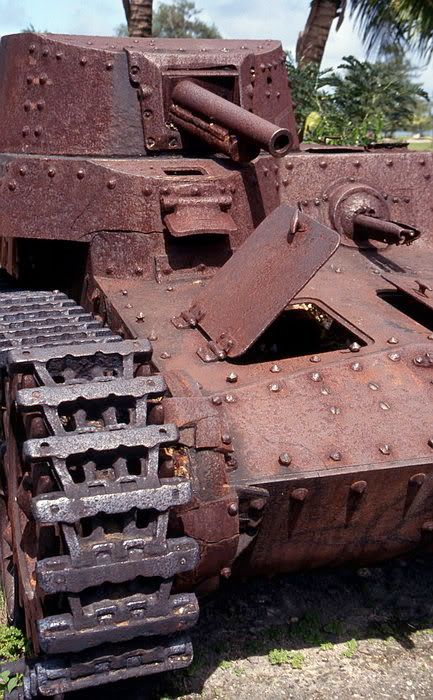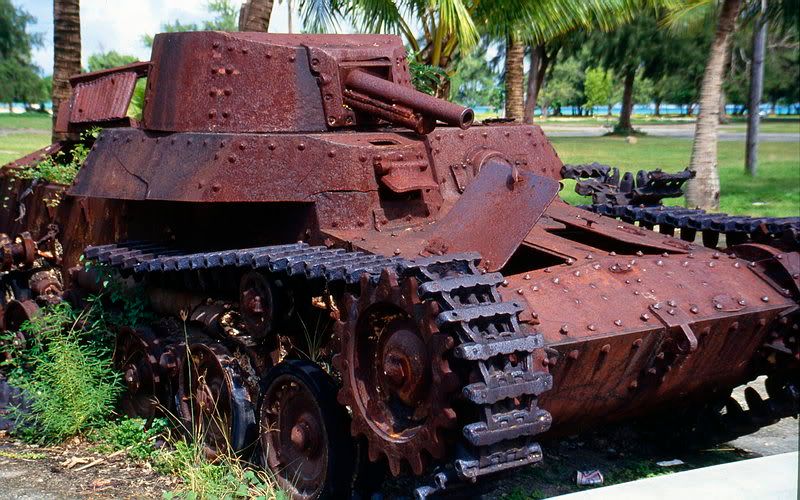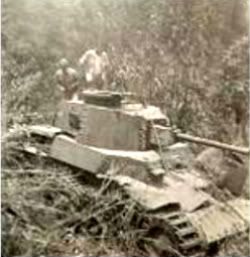|
|
Post by fots2 on May 27, 2009 16:50:42 GMT 8
Japanese Tanks (WWII relics)  Philippines  Philippines  Saipan, Commonwealth of the Northern Mariana Islands  Saipan, Commonwealth of the Northern Mariana Islands |
|
|
|
Post by batteryboy on May 27, 2009 17:52:39 GMT 8
Top photo:
Japanese Type 89b (I-Go) or "Chi-ro" Medium tank at Villa Escudero, Philippines
Bottom Photo
Japanese Type 97 (early ) "Chi Ha"
Cheers,
|
|
|
|
Post by chadhill on Oct 14, 2012 10:27:29 GMT 8
The following article is from the November 1982 issue of Quan. It is a translated summary from the Japanese press of 14th Army tank operations on Corregidor, by veteran Tadakuni Ichinose. I found the account fascinating and full of details I did not know about the battle.   * * * * * The Quan article did not include any photos. I have added some below. Corregidor, May 1942 ( Philippine Expeditionary Force, Gasei. Manila, May 1943)  Corregidor, May 1942 ( Philippine Expeditionary Force)  Corregidor, May 1942  Corregidor, 1952. Source unknown. Location on island unknown.  |
|
|
|
Post by chadhill on Oct 15, 2012 3:56:47 GMT 8
The last photo above has baffled me since I came across it on a personal website a year or so ago. I cannot find that site again, but as I recall it contained a collection of Corregidor photos taken by a former serviceman who visited The Rock a few years after the war. There were several other pictures posted that the serviceman had taken on Corregidor as well. All were dated 1952.  The tank appears to be a Type 97 Shinhoto Chi-ha, two of which were used in the 1942 assault as related in the Quan article above. Of course it would seem extremely unlikely that the tank shown in this 1952 photo would be one of those two. However, I could not remember reading any 1945 battle accounts of Japanese tanks in combat on Corregidor, but I am not well versed in the 1945 battle and unfortunately have a limited library about it. I spent part of this afternoon browsing thru Triumph in the Philippines, Back to Corregidor, and Corregidor, The Rock Force Assault but was unable to find any references to Japanese tanks in the 1945 battle. Finally, on pages 238-9 of Saga of a Fortress I found the following brief passage: "James Ravine, where heavy resistance had been expected, was cleared easily following two days of extremely effective strikes by P-47's armed with both five-hundred pound high-explosive bombs and napalm. Patrols discovered afterward that the searing, suffocating flame of the napalm had penetrated thirty-five feet into the chief center of resistance, the old underground infantry barracks, killing all of the Japanese inside by suffocation. A heavy bomb had transformed the lone enemy tank on Corregidor into an almost unrecognizable pile of junk". Although the tank in this photo does not strike me as being "almost unrecognizable", I think it may well be the one referred to. Can anyone shed any light on this? Thanks, Chad |
|
|
|
Post by EXO on Oct 15, 2012 6:58:50 GMT 8
"James Ravine, where heavy resistance had been expected, was cleared easily following two days of extremely effective strikes by P-47's armed with both five-hundred pound high-explosive bombs and napalm. Patrols discovered afterward that the searing, suffocating flame of the napalm had penetrated thirty-five feet into the chief center of resistance, the old underground infantry barracks, killing all of the Japanese inside by suffocation. A heavy bomb had transformed the lone enemy tank on Corregidor into an almost unrecognizable pile of junk". I tend to disagree with the learned authors' comment that James Ravine was "cleared easily." The task of clearing the ravine fell to "E" Company, and at the time "E" was commanded by Capt. Hudson Hill. During the first two attempts at taking the ravine, the lead platoons were pinned down by the Japanese, taking casualties. Indeed, one of the attempts trapped the men there and it took some work to extract them. This caused some criticism of Hill, who had not been with the patrol, but who had stayed in the safety of Topside. Thus, it was planned that the third attack down the Ravine would commence after an air strike. In cooperation with Bill Calhoun, have published Hudson Hill's Ft. Benning monograph on our website, but with a caution concerning aspects of its accuracy. Hill goes to some length writing about the James Ravine issue, and we suggest that this may have been because Hill was writing it partly to respond to criticism made concerning his failures there. (He was later relieved from command of "E".) Hill, a good fellow by most all accounts, was not entirely suited to be the CO of a rifle company. The link to Hill's paper is at the bottom of our cautionary introduction at: corregidor.org/BEA503/features/lostroad.htmlI have heard no discussions from any of the paratroopers that I have contacted concerning a Japanese tank on Corregidor. |
|
|
|
Post by pdh54 on Oct 15, 2012 12:21:22 GMT 8
Came across this article tonight. It's told from the Japanese side. www3.plala.or.jp/takihome/history.htmThe Philippines Date : Dec. 1941 to May, 1942 Place : The Philippines Opponent : US Army, Philippine Army Tank Unit / Commander / Tanks 4th Tank Regiment / Lieut. Colonel Kumagaya / 38 Type 95 Light Tanks 7th Tank Regiment / Colonel Sonoda / 34 Type 89Medium Tanks / 14 Type 95Light Tanks / 2 Type 97 Medium Tanks After the American air forces in the Philippines had been annihilated by the air raid of Japanese air forces, Japanese ground forces landed in Lingayen Gulf of Luzon on Dec. 22, and advanced towards Manila. On the Philippines, there were two American tank battalions equipped with M3 light tanks. M3 light tank was superior to any Japanese tanks regarding to the armor and firepower. However, the Americans were not prepared for flighting and they were confused with a sudden war. They tried counter-attacks by tanks but they could not stop the Japanese forces. After abandonned Manila, American forces withdrew to the Bataan Peninsula. The Bataan Peninsula was covered by jungle and the tank could not work in this battlefield. It was the Japanese artillery who played a decisive role in the battle of Bataan. The IJA deployed large artillery forces into Bataan and bombarded heavily. The Americans in Bataan surrendered in April, 1942. The last stand of the Americans on the Philippines was the Corregidor Island. Japanese artillery and airplanes bombarded the Corregidor fortress for one month and destroyed all coastal guns of the fortress. On May 5, Japanese ground forces attacked the Corregidor and succeeded to land 3 tanks, 2 Shinhoto Chi-Ha tanks and one captured M3 light tank. At that time, the production of Shinhoto Chi-Ha had just started and few numbers were available. After the encounter with M3 light tank, the Japanese transported Shinhoto Chi-Ha tanks to Philippine in a hurry. It was the first time for Shinhoto Chi-Ha to see action. The appearance of Japanese tanks panicked the garrisons of the Corregidor. Gen. Wainwright gave up the resistance and surrendered on May 6. Tried to post the photo of the tank too, but photobucket won't let me..........sorry Patty |
|
|
|
Post by chadhill on Oct 16, 2012 0:19:31 GMT 8
Thanks for the link, EXO, but it's having a snafu moment now...I'll try it again later. I will guess "easy" would rarely be an accurate description about any combat, am curious why the Belotes described it as such. I've re-found the site the 1952 photo came from. Although it's not a "personal" website as I mistakenly remembered, the Marines standing in the background are identified as Mahan and Mendon from Subic Bay, and other 1952 Corregidor tour pics are to be seen. Here's the link: subicbaymarines.com/images/1952/Page.htmlMaybe the tank was knocked out by the P-47s before it engaged US troops? Just a SWAG. I wonder if any parts remain around James Ravine, although I'm sure scrappers made off with the big stuff long ago. Thanks for the interesting info, pdh54. I recall you found and posted some things about that captured M3 tank, too. |
|
|
|
Post by EXO on Oct 16, 2012 6:36:12 GMT 8
Thanks for the note: I have corrected the links here and on the destination page: |
|
|
|
Post by chadhill on Oct 21, 2012 10:35:26 GMT 8
Thanks, EXO, the link is fine and it is good reading. It certainly was no cake walk for Easy Company in James Ravine. Hill's mono was interesting, too. Here is the Japanese photo pdh54 wanted to post of a Type 97 Shinhoto Chi-ha on Corregidor. I have not seen it before. I'm assuming from the accompanying text in Reply #5 that it was taken in 1942.  |
|
|
|
Post by chadhill on Mar 3, 2014 14:45:04 GMT 8
This photo is said to be of the captured M3 Stuart commanded by Captain Hideo Ho that landed on Corregidor May 6, 1942 with the two Type 97 tanks (see Quan article above, "Japanese Armor on Corregidor"). The Type 97s were unable to climb a ridge off the beach and had to be towed by the M3 up the grade.  In another thread, pdh54 posted this link to a 192nd Tank Battalion website that contained a biography of Sergeant Zenon R. Bardowski of Company B, 192nd Tank Battalion. Bardowski had commanded this particular tank on Bataan before escaping to Corregidor on April 8th, where he was assigned to Company D, 1st Battalion, 4th Marines. In a strange twist, on May 6th he found himself facing his old tank in combat: www.proviso.k12.il.us/bataan%20web/bardowski.htm |
|